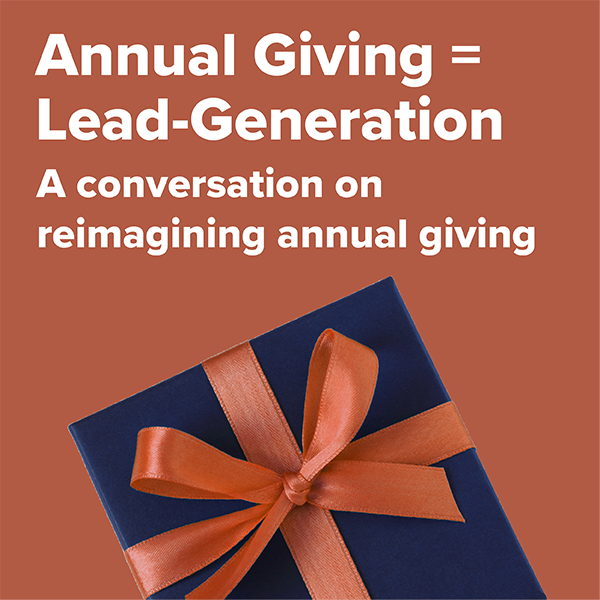Agree or disagree?
Lead gen is commonly associated with the for-profit world, but isn’t that concept what we’re applying in our day-to-day work in annual giving, too?
We’re trying to get more folks in the fold at the annual giving level in hopes they’ll be candidates for larger gifts down the road. And once they’re in the fold, we need to keep them engaged in order to push them through the pipeline and propel those leadership and major gift conversations.
In this big-picture discussion on the future of annual giving, Nick Linde, VP of Advancement at the University of Nebraska Foundation, shared his team’s efforts to engage their highest-potential, unassigned donors through their Donor Experience Program, which led to 100% coverage of 2,300 households, 500+ meetings, a 12-point increase in retention, and $3.1 million in new gifts and pipeline funds in its first year.
And, Alessandra Demmons, Director of Pipeline Development at the University of California, Berkeley, dove into the shifts her team is making to push more annual giving prospects up the pyramid into leadership and major gift portfolios.
Check out the full conversation to hear Nick and Alessandra’s thoughts on:
Shifting from static data to behavioral data
“Our lead generation had been extremely static for a long period of time”. This is likely a common occurrence at many institutions! Nick noted that for quite some time, the team was primarily focusing on donors who seemed to fit the bill after a wealth screening. But, what about the donors who made their first-ever gift of $100? $500? $1,000?
Now, the team is taking a more fluid look at how leads are generated. When someone makes a gift, their gift amount, and where they’re choosing to designate their gift to, are now weighed heavily in identifying a process for follow-up. Whether a handwritten card, a ThankView, or a 1:1 conversation to discover how they want to stay connected to the university, those donors are seeing more outreach to stay engaged.
Nick Linde on shifting from static data to behavioral data
"Pipeline flows both ways"
At UC Berkeley, the team is working to create systems and infrastructure to blend mass marketing and 1:1 outreach to engage the greatest number of people, most effectively. Alessandra noted pipeline and lead gen flows both ways. How many people you are pushing up through the pipeline is important, but it’s also critical to note how you’re prepping your team to engage folks who are going to remain loyal annual leadership level donors. What’s the strategy for the loyal donors who might not be looking to make a bigger gift later down the road?
Alessandra Demmons on why pipeline flows both ways
Three buckets for engaging pools of donors
One of the most-asked questions from the audience surrounded the University of Nebraska Foundation’s three buckets they categorize donor engagement into. Have no fear! We’ve outlined them here:
Bucket 1: Annual Giving Follow Up
- Regardless of age, wealth rating, or propensity scoring, anyone who makes a gift of $500 or more to the University of Nebraska Foundation will be contacted by a Donor Experience Officer within 90 days. This stems from a commitment to ensuring donors are heard and seen, so the Foundation can learn more about the philanthropic journey that donor wants to be on.
Bucket 2: Annual Giving Leadership follow up
- Using affinity and wealth scoring data, any donor that makes a gift of $100 or more that has a 5-year gift capacity of $100k or more will be reached out to by a development officer. This outreach includes a personal thanks, plus questions to determine if there are ways to further their engagement with the university. It comes with the recognition that they have the capacity to give, but might not be in the position to make a gift right now. How can you keep them consistently engaged so they can give more when the time is right?
Bucket 3: Planned Giving Follow Up
- The University of Nebraska Foundation looked at 10 years worth of data surrounding planned gifts. And, like is typical for many institutions, found key data indicators surrounding what a typical planned gift prospect looks like. Now, every time a donor with similar characteristics makes a gift, a member of the planned giving team reaches out to make a connection
The University of Nebraska Foundation's three buckets for engaging pools of donors
How to keep donors engaged if they don't want to meet...right now
Alessandra shared that the best way to make this happen is to make sure the donor understands the door is always open. It’s our responsibility to make sure that the donors know and understands the impact of their gift. Even if they don’t want to meet right now, we need to steward them. Things change – who’s to say they won’t want to talk in the future? And when they do, they’ll know there’s a resource at the University waiting for them.
Alessandra Demmons on how to keep donors engaged if they don't want to meet...right now
There are so many important parts of this conversation, it was hard to choose just a few! Make sure to check out the entire discussion and get ready to build that annual giving pipeline.
